|
1614 to 1664: From 'Ko-MO-sō' to 'Ko-MU-sō' - When That Actually Happened
The Broader Context - Essential Documentary Evidence Observed
'KOMO-SŌ' - 'FUKE-SŌ'/'FUKE KOMO-SŌ' - 'KOMU-SŌ'

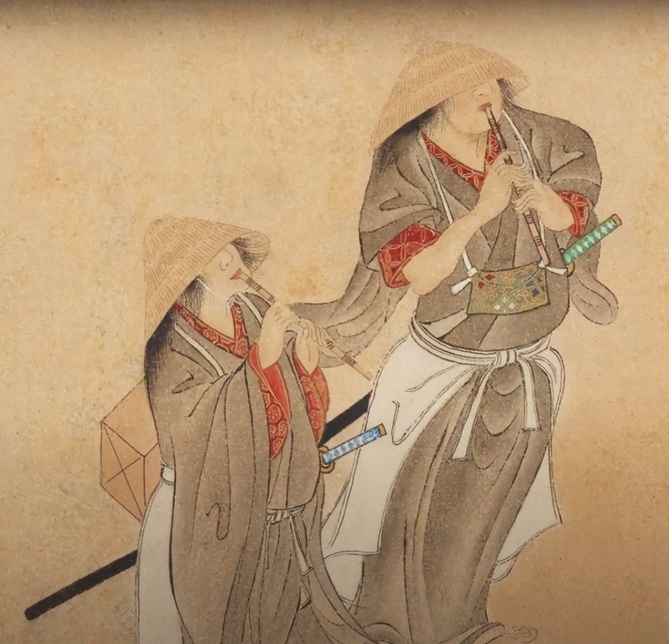

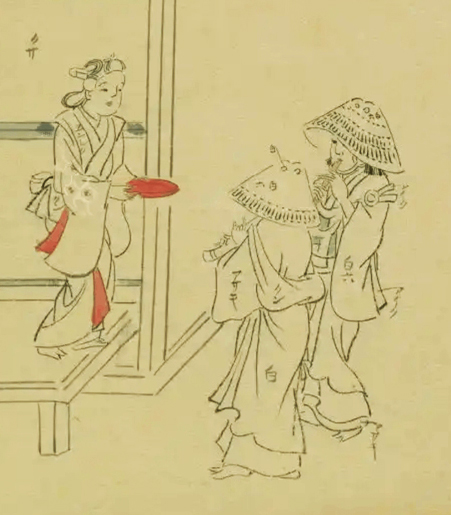
1494 - Mid-1620s - Early 1660s - 1682
Do note: The term/appellation 'komusō', 虚無僧,
"Monks of the Non-Dual & None-ness", was only thought out and coming into general use as late as since the early 1640s
- quite possibly, back then, as an invention by the renowned Rinzai Zen abbot and artist, Isshi Bunshu, 1608-1646.
Isshi Bunshu also laid down the basis for the narrative that long after his time manifested in the Kyotaku denki,
connecting the first 'Komusō' with Shinchi Kakushi/Hottō Kokushi of the Kōkoku Temple in Yura, Wakayama.
The Immediate socio-political background:
The De Facto RULING TOKUGAWA SHŌGUNS in this PERIOD:
Tokugawa Ieyasu: 1600 to 1616
Tokugawa Hidetada: 1616 to 1623
Tokugawa Iemitsu: 1623 to 1651
Tokugawa Ietsuna: 1651 to 1680
The THREE DOMINANT IDEOLOGIES in this PERIOD:
Neo-Confucianism, Shintō & Buddhism
1612: The persecution of Christian converts in Japan recommences.
1614, January 27:
Shōgun Tokugawa Ieyasu issues an edict completely prohibiting Christianity in Japan.
Attached to the edict are 15 rules for the guidance of the Buddhist priesthood in securing its enforcement, for instance,
" - - - everyone must become a member of one or another of the principal Buddhist sects, the head of the family being responsible for the choice thereof."
Source: C.R. Boxer, 1993, pp. 318-319.
Acc. to Wikipedia.org, "Between 1553 and 1620, eighty-six Daimyōs were officially baptized, and many more were sympathetic to the Christians."
Read more here: Wikipedia.org: Kirishitan
大坂
の
役 - ŌSAKA no EKI
1614-1615 - THE SIEGE and DEFEAT of ŌSAKA CASTLE



'Ōsaka-ge no jin-zu byōbu'.
The Ōsaka Castle Siege, Summer Campaign, 1614.
By various unnamed artists, by order of Kuroda Josui, 17th century.
In 1615 Tokugawa Ieyasu's army finally defeated the forces of Toyotomi Hideyori.
Around 70.000 of Hideyori's supporters are reported to have survived to become masterless samurai, or 'rōnin'.
Acc. to George B. Sansom (1964, vol. 3, pp. 32-33), the number of rōnin in Japan at this time may have reached a total of 500.000.
The VERY EARLY 1600s:
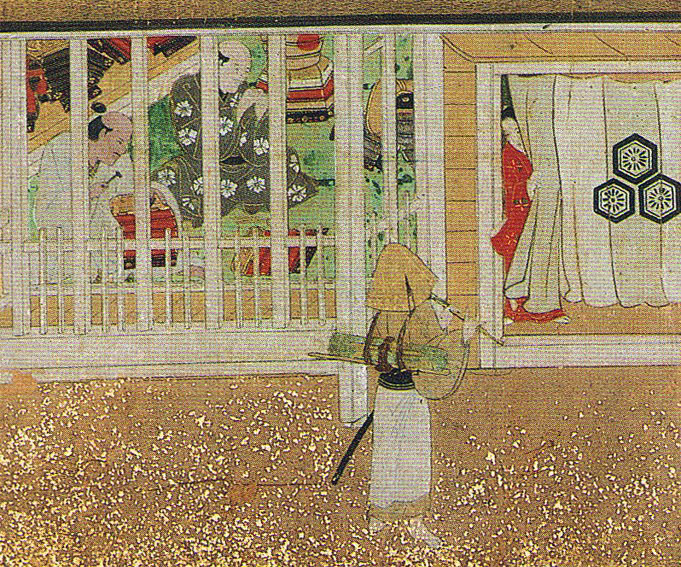
Yet not fully identified, so far precisely dated, very early 17th century 'komosō' image.
Apparently part of a quite typical Azuchi-Momoyama Period gold-leaf decorated folding screen
with everyday scenes, quite certainly dating from the very early 1600s.
Analysis: The person in that picture is obviously looking like a flute playing beggar
- notice the person in the door opening, looking out - a potential almsgiver.
The player, quite probably a male, wears a pointed basket hat, a rolled up sleeping mat on the back, and -
most notably: a long sword at his left side.
The flute, notably, is really thin and pretty long, very much looking like a 'dōshō',
洞簫, indeed.
1614:
慶長見聞集 - KEICHŌ KENMON-SHŪ by Miura Jōshin
浪人侍 - RŌNIN SAMURAI
尺八浪人 - SHAKUHACHI RŌNIN
修行 - SHUGYŌ
古無僧
Did the below told incident ever take place, possibly? Maybe not, or ...
Do note:
The Fuke Shakuhachi player being quoted in the following text WAS NOT a 'KOMUSŌ'!
The shakuhachi-playing laymonk in this anecdote, of samurai heritage, is described by Miura Jōshin as a ko-mu-sō,
古無僧, "old+none-ness+monk", the reason simply being that the author did not know how to write the term
komo-sō correctly.
The confusion of the phonems mo and mu is certainly not uncommon at all, as those two syllables are virtual homonyms, phonetically.
At this very time in history a mendicant 'shakuhachi' "lay monk" would rightly still be known as a 'Fuke komo-sō', not a 'komu-sō'.
There were quite certainly no 'komu-sō', 虚無僧,
in existence in Japan before sometime after the Shimabara Rebellion on Kyūshū in Southern Japan in 1637-38, at the earliest.
- - -
われいにしへは四姓の上首たりといへ共、
今は世を捨人となる。
然共先業をかへり見、貧賎をなげかずして、
仏道の縁に取付、宗門に思ひをすまし、
内に所得なく、外に所求なく、
身を安くして、普化上人の跡をつぎ、
一代教門の肝心出離解脱の道に入、
修行をはげますといへ共、
悪逆無道の一言にわれしんいの
ほのほやみがたしすがたこそ。
- - -
" - - - Although many years ago I held a high position, now I have become one who has abandoned the world.
But when I recall my former occupation, I do not grieve over poverty and lowliness but hold on to the fate of the Way of the Buddha
and reserve all my considerations for the Doctrine.
I have no inward possessions, no outward desires, and I calmly follow in the footprints of Priest Fuke
and have entered upon the way of True Detachment and Spiritual Deliverance.
But even though I strive hard in ascetic discipline [shugyō,
修行],
I find it difficult indeed to maintain a peaceful mind when I am confronted with an atrocious word. - - - "
Miura Jōshin (1565-1644) quoting a travelling Fuke monk
being characterized in his kanazōshi book 'Keichō Kenmon-shū',
'Seen and Heard during the Keichō Period', 1614.
Trsl. by Torsten Olafsson.
Sources: Kurihara, 1918/1975, pp. 183-184. (& Koji ruien vol. 37)
脇
さし - WAKIZASHI
THE FUKE-MONK's SHORT SWORD
Evidently, the Fuke Shakuhachi player being described by Miura Jōshin was equipped with a sword:
吉光の脇ざし一腰持たりとて座中へ出す。
"[The komusō] drew out in the open the short sword [wakizashi] he was carrying by his side, proclaiming that it was a genuine 'Yoshimitsu'."
Source: 'Keichō Kenmon-shū', 1614.
Trsl. from Torsten Olafsson, 1987, p. 117.
武家諸法度 - BUKE SHOHATTO
1615
"Ordinances for the Military Houses"

Source: http://www42.tok2.com/home/toyotane/bukesyohatto.html
In 1615, the "Ordinances for the Military Houses", Buke shohatto, totalling 13 paragraphs, are promulgated. Selected clauses:
(1) "The study of literature and the practice of the military arts must be pursued side by side."
(3) "Those who break the laws are not to be given shelter in any fief."
(5) "No sanctuary is to be given to men who plot rebellion or incite risings.
Hereafter residence in a fief shall be limited to men born in that fief."
(7) "Should it be learned that in a neighbouring fief there are men who plot changes and form parties or factions to carry them out,
they must at once be denounced [to the Bakufu]."
(12) "All samurai in all fiefs are to live frugally."
Trsl. by George B. Sansom, 1964, vol. 3, pp. 7-8.
Also see Takahashi, 1990, pp. 48-50.
The 'Buke shohatto' was drawn up on Shōgun Tokugawa Ieyasu's
instructions by the Zen Monk Ishin Sūden, 1569-1633.
The original manuscript is owned by the Konchi-in temple in Kyōto.
Hidetada is the ruling Tokugawa shōgun from 1616 to 1623.
1621:
暮露暮露 - BOROBORO
薦僧 - KOMOSŌ
徒然草野槌 - TSUREZUREGUSA NOZUCHI by HAYASHI RAZAN
" - - - According to the 'Boro-boro Story Book', the empty sky priests were 7 feet 8 inches tall and tough and strong.
Clad in paper garments decorated with designs, they carried swords which were 1 foot 8 inches long, and held octagonal, rattan-wound shafts by their sides.
Walking on high clogs 1 foot 5 inches tall, their hair long and black, they came to be known as 'Boro'.
It is being said that they took beautiful wives as spouses and travelled together all over the country in groups of thirty."
其後に薦僧と云もの僧とも見えず俗とも見えず山伏ともみえず,
刀をさし尺八を吹せなかにむしろをおひ道路をありき人の門戸に立て物を乞もらふ.
是ぼろ々々の流也, と云傳へたり。
"Later, as for the 'Komosō', they appear to have been neither monks, laymen, nor 'yamabushi'.
They wore swords and blew the shakuhachi.
Carrying straw mats on their backs they wandered the roads and, they begged for and received alms at people's gates.
This, I am told, is the tradition of the 'Boroboro'. - - - "
Hayashi Razan, 1583-1657, in 'Tsurezuregusa nozuchi':
Excursions into the Tsurezuregusa". Written in 1621. Published in 1648.
Printed in 1667. Trsl. by Torsten Olafsson, 1986-87.
First source: Kurihara Kōta, 1918.

Hayashi Razan (a.k.a. Hayashi Dōshun) - artist and date unknown
元和
の
大殉教 - GENNA no DAIJUNKYŌ
1622:
The "Great Genna Martyrdom" at Nagasaki.
55 arrested Christians die from torture, exhaustion or execution.
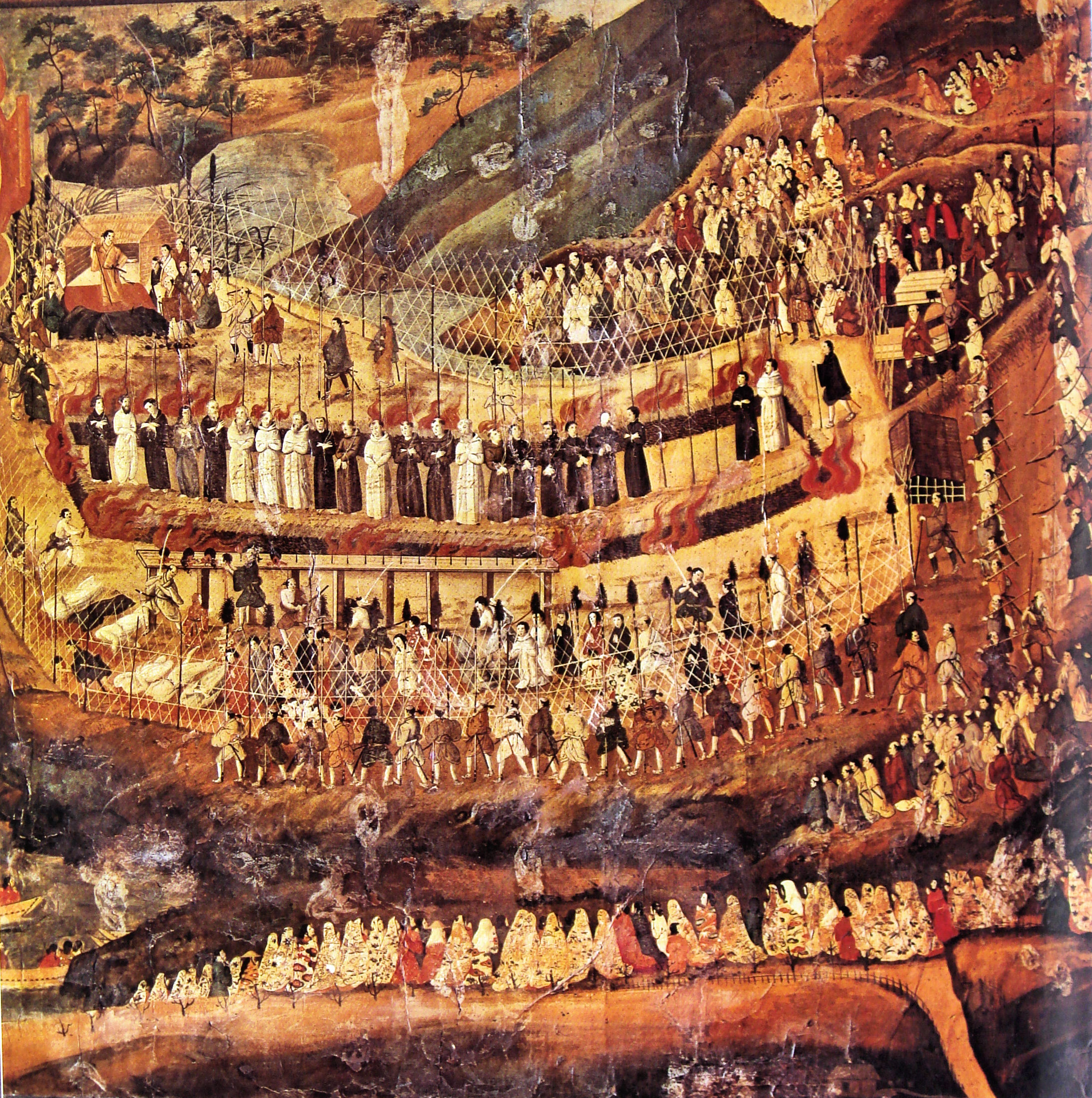
"The Great Genna Martyrdom in Nagasaki"
Painting by unnamed Japanese artist.
Iemitsu is the ruling Tokugawa shōgun from 1623 to 1651.
江戸
の
大殉教 - EDO no DAIJUNKYŌ
1623: The "Great Martyrdom of Edo".
First 50, soon afterwards further 37 Christians are executed.

"The Great Martyrdom in Edo"
Painting by unnamed Japanese artist.
尺八記
1623 - SHAKUHACHI (no) KI by HAYASHI RAZAN
吾國近代有宇治庵主狂雲子一路叟者並避世之徒也。
倶吹尺八。
" - - - In our country, in recent times, there were [two] persons who lived as hermits in
Uji, Kyōun [pseudonym for Ikkyū Sōjun,
一休宗純, 1394-1481]
and Ichirōsō, who had abandoned the world.
They [both] played the shakuhachi [together]. - - - "
Hayashi Razan, 1583-1657, in 'Shakuhachi (no) ki',
"Shakuhachi Chronicle". Dated Genna 9, 1623.
Trsl. by Torsten Olafsson, 2013. In vol. 19 of:
Hayashi Razan bunshū, "Collected Writings by
Hayashi Razan", Kōbunsha, Kyōto, 1930, pp. 217.
1623:
普化僧 - FUKE-SŌ
薦僧 - KOMOSŌ
醒睡笑 - SEISUISHŌ by Anrakuan Sakuden
"Laughs to Wake You Up"
尾州祐福寺に沢良という長老所談の砌、
こもそう一人来たり庭にてきく。
沢良、椽にあがりてとあれば、
心得候と椽にあがる。
兎角しくべきものなしと、
沢良再、普化僧とよぶ。
やっとこたう。其こもおしけ。
"While, at one occasion, I had a conversation with an elder named Sawarō [?]
at the temple Yūfuku-ji in Bishū [mod. Aichi Pref.],
I heard a komosō who had arrived [and played] in the courtyard.
When Sawarō asked him to come up [and join us] on the veranda [where we
were sitting], he readily stepped on the veranda.
As, somehow or other, there was nothing [for him] to sit on,
Sawarō addressed him a second time, [this time] as "Fuke Monk" [Jap.: 'Fuke-sō]'.
After some time, finally he [the 'komosō'] responded.
He unrolled his sitting mat."
Anrakuan Sakuden, 1554-1642, in 'Seisuishō', "Laughter
Which Disperses Sleep", 1623, maki 8. Trsl. by Torsten Olafsson, 2010.
Sources: Ueno, 1984, pp. 206-207, and
The Komazawa University Library Text Database
餘音尺八記
1625 - YO-IN SHAKUHACHI (no) KI by HAYASHI RAZAN
Hayashi Razan, 1583-1657, in 'Yo-in shakuhachi (no) ki',
"Further Notes to the Shakuhachi Chronicle". Dated Genna 11, 1625.
In vol. 19 of:
Hayashi Razan bunshū, "Collected Writings by
Hayashi Razan", Kōbunsha, Kyōto, 1930, pp. 218.
Link to online version:
Hayashi Razan bunshū
See also: Linder, 2012, p. 213.
1626-1633: The Nagasaki city magistrate Mizuno Kawachi-no-kami and his successor Terazawa Hirotake organize a "reign of terror" against Christian converts,
most of them peasants, in the districts under their control on the Southern island of Kyūshū.
1624-1630 - Early Kan'ei Period:
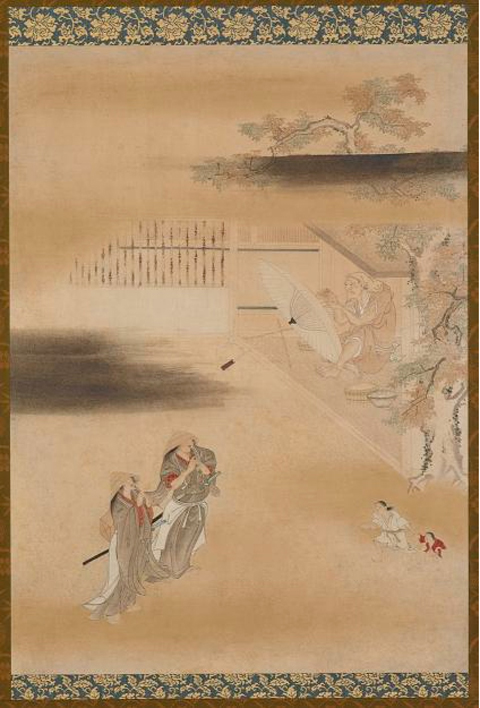
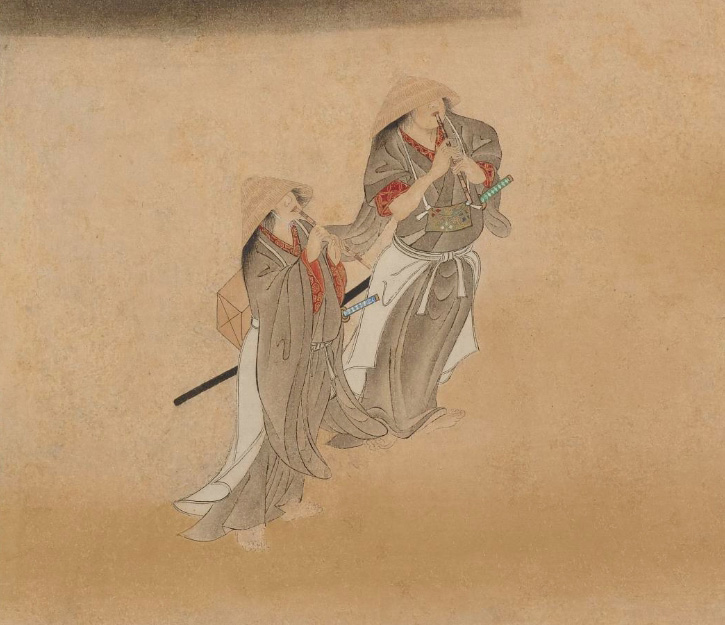
Iwasa Matabei's painting of Two Komosō & An Umbrella Maker, detail.
Now in the possession of the Smithsonian/Freer Gallery of Art, Washington D.C.
Dated no later than 1630, according to Japanese art historians
c/o the Nezu Museum in Tokyo.
1628
海道本則 - KAIDŌ HONSOKU
Also being referred to, titled and recognized as:
暮露薦僧本則 - BORO KOMOSŌ HONSOKU
暮露虚無僧本則 - BORO KOMUSŌ HONSOKU
暮露の手帳 - BORO no TECHŌ
暮露の手記 - BORO no SHUKI
KAIDŌ HONSOKU - SELECTED QUOTATIONS in random order:
コモト云フソノ水上ヲタスヌルニ
古モナク、 今モナシ、
亦云、 三界ハ無法、
見モノノママニ、
柳ハ緑、花ハ紅トモ申ナリ、
コモト云ソノ水上ノナカリセハ、
世ニヲチ人ノ家ハナキモノ、
サテ亦長門ニテ赤間カ關、
洛陽ニテ相坂ノ關、
奥州ニテ白河二所ノ關、
三關今役ナクシラ、
天地同根、萬物一體
天地豊繞ノコモニ、
關モ役モナシ、
"If you inquire about the Komo’s place of origin, the answer is:
'Neither in the Past nor in the Present!'
Or, to put it in the words of Banzan:
'The Three-fold World is Immaterial!'
Any attempt at answering the question would be just as meaningless as saying ‘the willow
is verdurous, the flower is crimson’!
Instead of a place of origin, the Komo are scattered in the world without such a place to call home.
And now, being deprived of employment anywhere, be it at any of the three barriers of
Akama-ga-seki in the Nagato Province, Ōsaka-no-seki at the [old] capital [Kyōto], or the two checking stations
of Shirakawa in Ōshū, the Komo who abundantly wander the world, to whom Heaven
and Earth have the Same Root and All Creation is One Body, have neither confinements nor attachments."
薦ハ何クカラ来テソフソ(ロ?)、
暗頭来也、暗キ國カラカ
明頭来也、明ナル國カラ歟、
"Where from does the Komo come?
Fuke said,
'The Dualistic Notion of "Darkness" appears ... '
Does he come from the Realm of Obscurity?
Fuke said,
'The Dualistic Notion of "Brightness" appears ... '
Does he come from the Realm of Clarity?"
三ノ節ハ三身一體、
本ノ切口ハ金剛界、
上ノ圓キ歌口ハ心月明ノマナヒナ、
合テ七百餘尊ナリ、
"The three nodes represent the Oneness of the Three Bodies, the lower opening the Womb Realm, the upper opening the Diamond Realm,
and the crescent-shaped mouthpiece above teaches the Clarity of Absolute Reality.
The shakuhachi is precious beyond limit."
薦ノ持タル竹ニフシンカ候ヨ、
尺八者コモノ重寶ヲ以テ、
四節四穴ト表スルナリ、
"Oh, how mysterious is the bamboo flute that the Komo carries!
The shakuhachi is the principal treasure of the Komo and it represents the Four Seasons symbolized by the four finger holes on the front."
尺八ノ、聲ノ内ナル、隱レカヲ、
タスネテ見ハ、元ノ竹カナ、
"When you search, and find
in shakuhachi sound your refuge,
is that not indeed
the essence of bamboo?"
尺八ノ、聲ノ内ナル、隱レカハ、
宮城野ニ吹く、春(ノ)風カナ、
"Choosing as one's hermitage
the voice of the shakuhachi,
is that not the Spring breeze
blowing at Miyagi-no?"
Quoted from the 'Kaidō Honsoku', anon., 1628.
Trsl. by Torsten Olafsson, 1987, 2003, 2024.
Sources: Nakatsuka, 1979 & Shūhō Yokō, 1938/1981.
For a complete translation of 'Kaidō honsoku',
please visit this web page: Kaidō honsoku
刀 - KATANA
THE MATMONK's SWORD
コモノ指タル刀ニフシンカソロソ、
屏風カ蒲團カ、
普化ハ七腰サシタト普化。
"How mysterious, indeed, is the sword that the Komo is carrying!
[Even at his master Banzan's death bed, ed.] Fuke made a somersault over the screen and mattress, it is being told!"
Trsl. from Torsten Olafsson, 1987, p. 17.
1628?: Did an angry and revengeful 'Komusō' commit assault, or murder, in the Province of Tosa on the island of Shikoku?
Source: Hosaka Hiro'oki, 1994
1628: KAIDŌ HONSOKU
薦僧開山普化和尚末派十六派
KOMOSŌ KAIZAN FUKE OSHŌ MAPPA JŪROKU-HA
The 16 Branches of the Komosō Founder Priest Fuke's Denomination
- as listed in the Kaidō honsoku document.

The 16 branches of Priest Fuke's denomination
as recorded in the Kaidō honsoku document of 1628
Printed by the Kōkoku-ji, Yura, in Shūhō Yokō, 1981 (1938), p. 74

Map of the 16 branches of Priest Fuke's denomination
as recorded in the Kaidō honsoku document of 1628
Source: Torsten Olafsson's 'Kaidō honsoku' thesis, 1987
Is the Fuke Shakuhachi branch Nezasa-ha, 根笹派, listed in a document dated 1628?
The answer is "no"!
Read more in the Introduction.
薦僧開山普化和尚末派十六派アリ、
1: 一 ワカサリ門派
2: 一 筑紫ニイヌヤロウ門派
3: 一 北國ノキハ門派
4: 一 中國ニノキハ門派
5: 一 伊勢ニサカハヤシ門派
6: 一 五畿内ヤワタノキハ門派
7: 一 武蔵カカリ門派
8: 一 美濃ニ若衆門派
9: 一 上州ニサラハ門派
10: 一 中武蔵ニヨリタケ門派
11: 一 下總ニキンゼン門派
12: 一 下野ニコキクハ門派
13: 一 奥州ニタンシヤクヨロコヒ門派
14: 一 常陸ニウメシ門派
15: 一 奥州ニタンシヤク派ヨ
16: 一 北國ニカンタキノハ門派
Par. 19(18):
The Komosō founder Priest Fuke’s sect has 16 branches:
1: The Wakasari Branch Sect [unidentified]
2: The Inu-yarō Branch Sect in Tsukushi [present Kyūshū]
3: The Hokkoku Noki-ha Branch Sect [NW Honshū]
4: The Noki-ha Branch Sect in Chūgoku [SW Honshū]
5: The Sakabayashi Branch Sect in Ise [present Mie Prefecture]
6: The Gokinai Yawata Noki-ha Branch Sect [present Kyōto area]
7: The Kakari Branch Sect in Musashi [present Tōkyō area]
8: The Wakashū Branch Sect in Minō [present Gifu Prefecture]
9: The Sara-ha Branch Sect in Jōshū [present Gumma Prefecture]
10: The Yoritake Branch Sect in Central Musashi [present Tōkyō area]
11: The Kinzen Branch Sect in Shimōsa [present Chiba Prefecture]
12: The Kogiku-ha Branch Sect in Shimotsuke [present Tochigi Pref.]
13: The Tanjaku Yorokobi Branch Sect in Ōshū [NE Honshū]
14: The Umeji Branch Sect in Hitachi [present Ibaraki Prefecture]
15: The Additional Tanjaku Branch in Ōshū [NE Honshū]
16: The Kandan-ki no ha Branch Sect in Hokkoku [NW Honshū]
踏
み
絵 - FUMI-E
1629:
The practice of fumi-e, 踏み絵 - the forced trampling of Christian images - is introduced and kept in constant national execution and effect turough the year 1858.
The religious authorities of the Tokugawa shōgunate requires suspected Christians to step on images of Jesus Christ or the Virgin Mary in order to prove that they are not members of that outlawed religion.


Fumi-e: Jesus Christ & the Virgin Mary

Painting of a 'fumi-e' inquisitional ceremony by Keiga Kawahara, 1786–1860?, a citizen of Nagasaki,
created sometime during 1800-1829.
Source: National Library of the Netherlands. Link:
geheugenvannederland.nl
武家諸法度 - BUKE SHOHATTO
1635 - The Bakufu orders all 'daimyō' and military families to reinforce the Christianity prohibition laws and perform strict persecution routines.
1630s ...


The 'ana-tsurushi' method of inquisitioning and torturing stubborn and resisting Japanese Christian converts,
intensifying in the 1630s and 1640s
Image sources: Facebook and Wikipedia
寺社奉行 - JISHA BUGYŌ
1635 - The Jisha bugyō, Magistrate of Temples and Shrines, is officially established as a permanent position.
Four Jisha bugyō, "temple & shrines magistrates", are appointed from among the fudai daimyō, and
since now they take turns in the position for one-month intervals.
島原
の
乱 - SHIMABARA no RAN
1637-1638 - The SHIMABARA REBELLION
1637: Christian farmers, warriors, rōnin (masterless samurai) and others revolt against the authorities on the Shimabara Peninsula in Kyūshū.
When the uprising was put down in 1638, tens of thousands had been killed.
Christianity was now strictly outlawed in Japan and informers were encouraged.
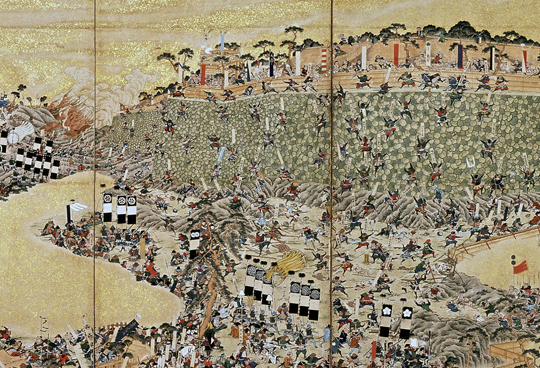
'Shimabara ran-zu byōbu'
"Folding screen depicting the rebellion at Shimabara".
Source: Wikipedia.

Map of Hara Castle, Shimabara. Source: Wikipedia.
1639, July 5: The captain-major of two visiting Portuguese ships at Nagasaki is presented with a copy of a decree
which orders the immediate and permanent cessation of all trade between the Portuguese and Japan.
1640?: Was a very early "Komusō temple" really built in Nagasaki on the island of Kyūshū in 1640?
1640, July: A portuguese vessel carrying a specially selected embassy reaches Nagasaki in one last attempt to persuade the shōgun to change his mind.
On August 1, the entire party is arrested and imprisoned.
1640, August 4: 61 of the prisoners are executed on "Martyr's Mount" - 13 native crew members are spared and sent back to the Portuguese colony Macao,
to report what has happened.
Source: C.R. Boxer, 1993, pp. 384-385.
宗門改役 - SHŪMON ARATAME-YAKU
檀家制度 - DANKA SEIDO
In 1640, in direct consequence of the Shimabara Rebellion, the Tokugawa Bakufu orders the so called Shūmon aratame-yaku,
or "officers for examining the religious sects", to be set up.
From this time on, the major sects of Buddhism were made responsible for producing registers of religious affiliation of every Japanese household with one specific Buddhist temple.
The socalled Danka seido, or "Danka System", in which Japanese households since the Heian Period, 794-1185, had voluntarily been supporting the temples financially,
was now reshaped into a most effective instrument with which the government could monitor the population and - first of all - suppress and eliminate the Christian faith and its believers, on a mandatory basis.
Read more about the Danka seido - and the very important socalled tera-uke
寺請, or "temple certificates", issued annually by the temples - on these pages:
Wikipedia: The Danka system
Even though the later komusō fraternity was, seemingly, to some extent officially recognized by the Tokugawa government in January, 1678,
in some capacity as a "semi-religious brotherhood", the komusō "temples" did not play any role in administering and partaking professionally in the Danka System of the Edo Period at all.
Furthermore, the komusō are not known to have performed formal funeral and ancestor commemoration services,
nor do the komusō temples appear to have had any cemeteries for the common population - nor themselves! - within their precincts. *
This possibly explains, at least in part, why it did not require much more than a few brush strokes for the new Meiji Government - in October, 1871 -
to completely bring an end to the komusō tradition.
* See f.i. Yamaguchi Masayoshi, 2005, p. 187.
1640-1658: INOUE CHIKUGO-no-KAMI MASASHIGE - Chief Anti_Catholic Inquisitor
The first national sects inspection chief inquisitor is appointed by Tokugawa Iemitsu Shōgun:
Inoue Chikugo-no-Kami Masashige, commonly known but as Inoue Masashige,
井上筑後の守政重, 1585-1661,
served in high-ranking government office, leading the nationwide 'Shūmon aratame-yaku' anti-Christian inquisition organization, from 1640 till 1658,
while most efficiently supervising the nationwide persecution and virtually total elimination of all Christian, Catholic converts
that was most efficiently maintained in Japan till shortly before the end of the Tokugawa Period, in 1859.
Inoue's title appears to have been that of 'shūnin",
就任,
"Official Inspector".
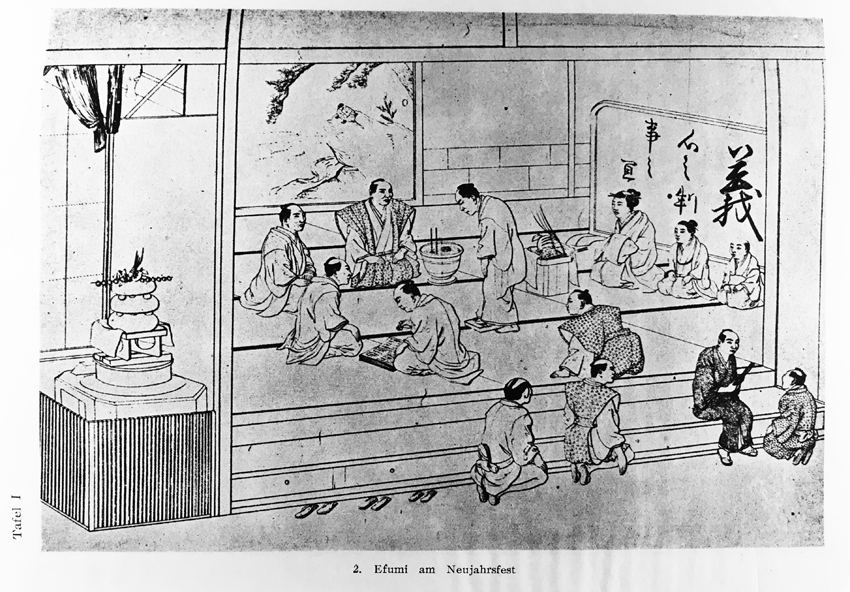
Fumi-e inquisition test. No date, artist unknown.
Source: Voss & Cieslik, 1940, inserted between pages 40 and 41 in the book.
契利斯督記
KIRISHITO-KI - An anti-Christian inquisitors manual by Inoue Masashige
1640-1658: Inoue Chikugo-no-Kami Masashige writes detailed instructions for the persecutions of Christian converts
during his tenure as first chief religious sects inquisitor appointed by Tokugawa Iemitsu Shōgun.
That "manual for inquisitors" hunting down and exterminating Christian converts was created for internal use only and first compiled under Inoue's successor in office,
Hōjō Awa no Kami Ujinaga,
北条阿波の守氏名(?), no dates, yet.
George Elison, in his monumental work "Deus Destroyed", 1988 (1973), introduces Document VII that focuses on methods of investigation and punishment like this:
"Information on Christianity and its diffusion in Japan is one part of the contents of Kirishito-ki.
But the most significant portions of this manual are those which deal with the methods of the shūmon-aratame yaku.
The greater part of the documents was compiled during the early years of tenure of the second Inquisitor, Hōjō Awano Kami Ujinaga, who succeeded Inoue in 1658.
Inoue departed the office in circumstances that were less than glorious.
His prosecution of the anti-Christian policy had for almost twenty years seemed successful.
But the seed had not really been extirpated: in 1657, 608 Christians were discovered in Ōmura; 411 of these proved unregenerate and were executed.
The incident may well have contributed to Inoue's resignation.
The Kirishito-ki is Inoue's monument, and in the main represents his effort to initiate Hōjō Awa into his duties.
The documents were meant strictly for internal use, and not for propaganda.
As Cieslik and Voss point out [Voss & Cieslik, 1940, see bibliography below, ed.], this unquestionable measure of authenticity greatly increases their value for the historian.
The purpose and procedures of the inquisition are herein revealed in all their grim sobriety and downright terrifying banality.
The meticulous nature of the process is best illustrated in Document VII of the compendium, which deserves quotation in extenso":

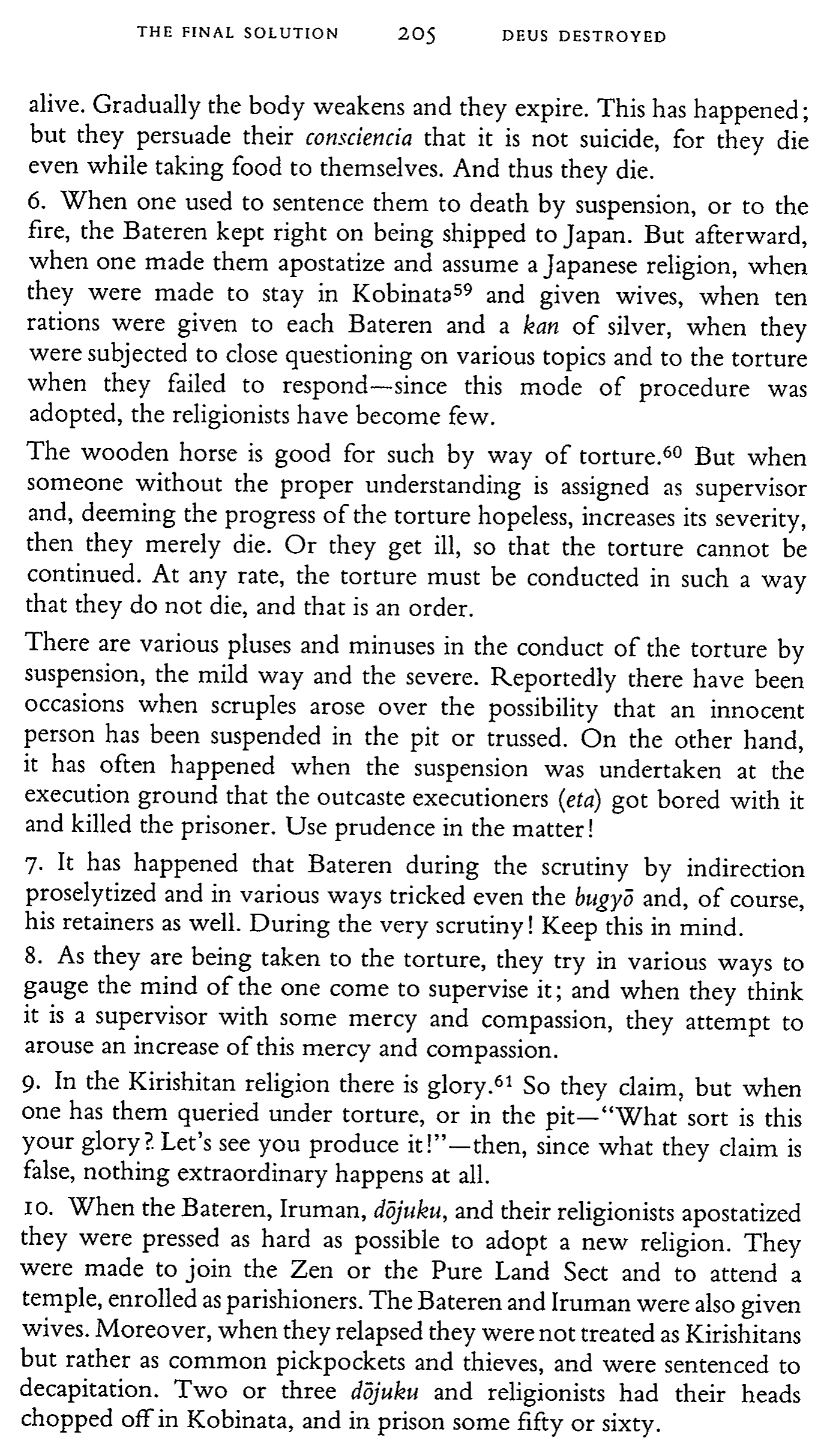
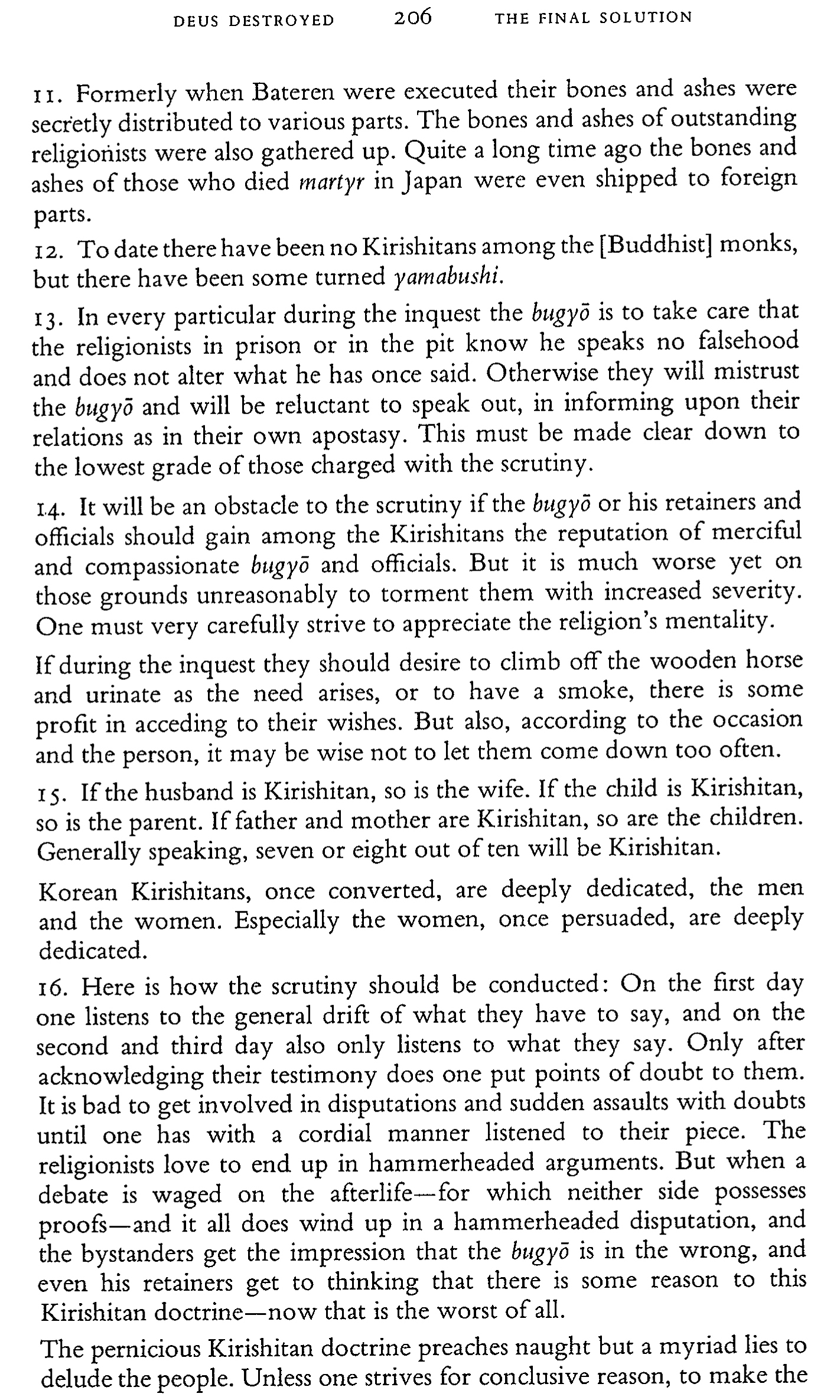

George Elison's translation of Inoue Masashige's Document VII regarding investigation, prosecution, and punishment of Christian converts.
Link to an online edition of the 'Kirishito-ki' c/o the Library of Tokyo University
1640s - No later than 1646:
LETTER from ISSHI BUNSHU 一絲文守
to the First EVER NAMED KOMUSŌ SANDŌ MUGETSU
山道無月
法燈國師 - HOTTŌ KOKUSHI
虚無四人 - KYOMU YONIN
無孔笛 - MUKUTEKI
無絃琴 - MUGENKIN
HOTTŌ KOKUSHI & The INVENTED "FOUR 'KYOMU' BUDDHIST LAYMEN"
The FLUTE WITHOUT HOLES & The ZITHER WiTHOUT STRINGS


Isshi's Letter to the komusō Sandō Mugetsu
Left: Concluding part of scroll - right: Opening part of scroll
The PRESERVED ISSHI BUNSHU DOCUMENT
Here is my own scanning, carefully and thoroughly retouched and sufficiently cleaned, of a xerox copy of the original Isshi Bunshu hand-scroll,
supplied to me in April, 1985, by Yamakawa Sōkyū of the Kōkoku Rinzai Zen Temple in Yura, Wakayama.

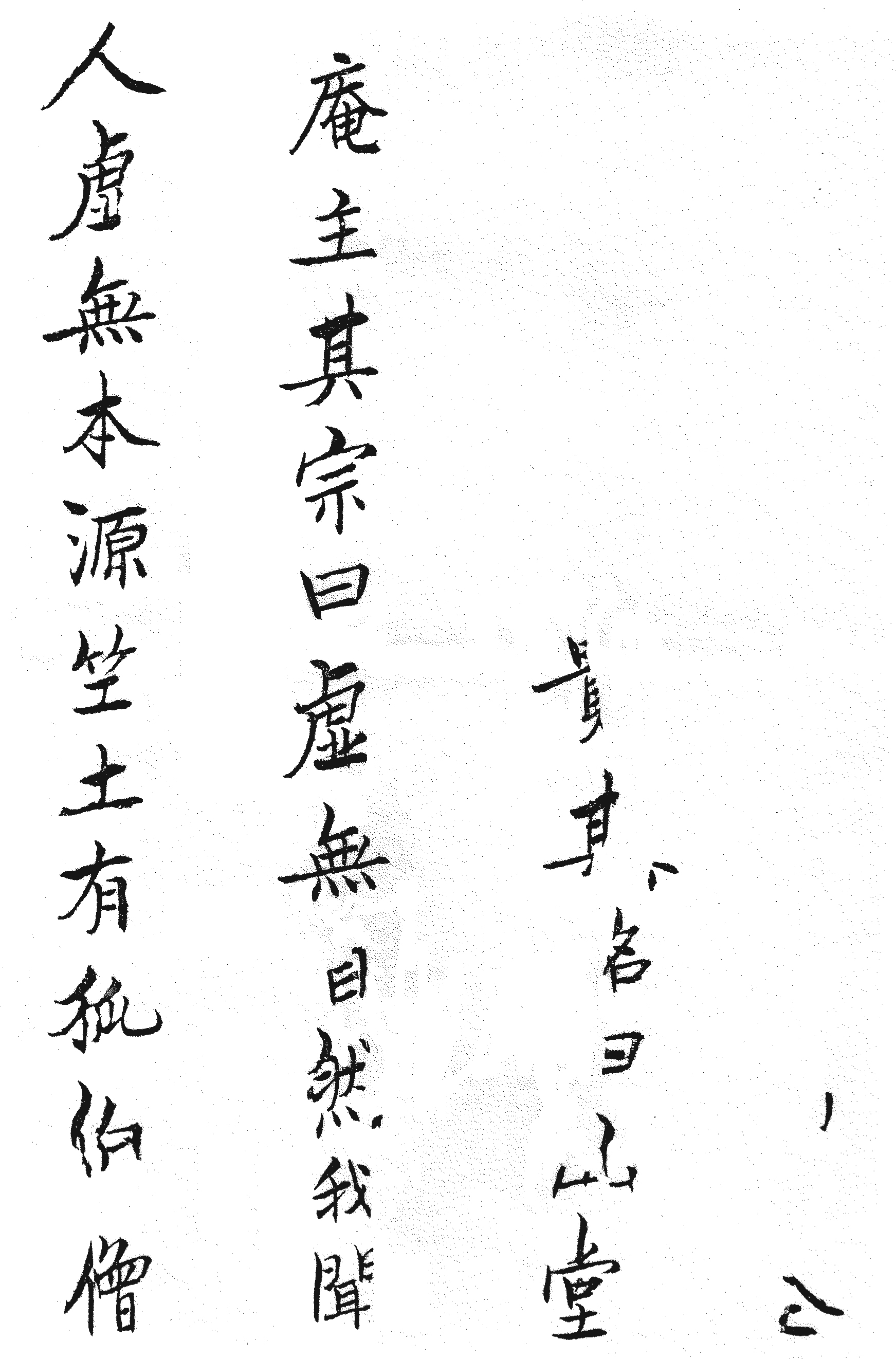
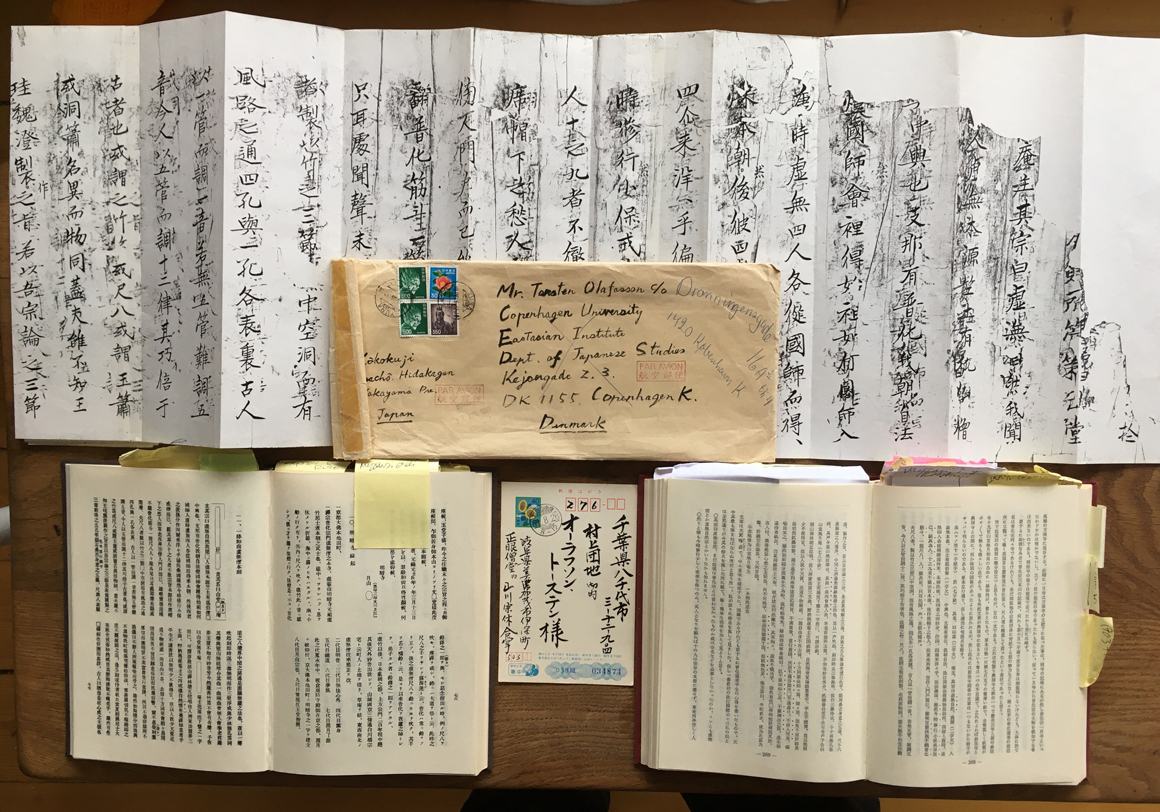
Here you see the opening section of my xerox copy of the original letter from Isshi Bunshu to the 'komusō' Sandō Mugetsu
that was made and sent to me
by Yamakawa Sōkyū,
山川宗休,
of the Kōkoku-ji in Yura, Wakayama Pref., in early 1985.
In the picture you also see Isshi's letter as reprinted in Mori, 1981 (1st edition 1938),
and Nakatsuka, 1979 - two absolutely essential literary sources
of ascetic shakuhachi history and ideology.
TRANSLATIONS from ISSHI BUNSHU's LETTER to SANDŌ MUGETSU:
- - -
"In China there was Fuke; [as for] my [own] country itself, how possibly could Hottō Kokushi accomplish as the originator of the congregation?
When Kokushi was in China, one after the other four Kyomu people joined him and, succesfully, came [back with Kokushi] to this country.
Later, the paths [lit.: 'branch veins'] of these honorary men separated into four, respectively [thus totalling 16], and - travelling in all directions -
wherever they came they brought relief to the Buddhist community."
- - -
"The shakuhachi is made from a piece of bamboo with 3 nodes
with a hollow cavity cut out inside of it.
Then, when the airstream can pass through, four and one holes [are drilled] on the front and on the back, respectively.
The ancients used a single pipe to produce one single sound.
In case there were not 5 pipes, it was difficult to tune the five notes properly.
Today's people use 5 pipes to tune the 12 steps [i.e.: the 12 semitones of the octave].
This is a special skill which originated in ancient times.
Some people call it 'Take', or 'Shakuhachi' - some call it 'Jade Flute',
while others say 'Dōshō'.
Although the names differ, it is the same.
Obviously, whoever they may be, if one does not acknowledge the 'Lofty Clearness of the Jade Sceptre' and the principles of manufacture,
taking into consideration the Three Essential Issues [Jap.: 'mi-bushi']
of our school's philosophy, that represents the Three Poisons [or Malices] of Greed, Anger, and Ignorance.
May [the distribution of] the five holes on the front and on the back, respectively, possibly correspond to the discrimination between Thinking
[lit.: "receiving ideas"] and Sensation [lit.: "distinguishing colors"] - and the five powers of the Eye, Ear, Nose, Tongue, and Body-Mind?
[The compound] 'Shaku' and 'Hachi' expresses every aspect of the Eight Boundaries [lit.: "Right & Wrong", namely: the "Environment Determined by Karma"].
As for the hollow cavity of the pipe, that symbolizes the Doctrine of the Universally Conciliated Absence of any Beginning.
With ever increasing force it blows forth, with one voice, immediately eliminating the Muddy Illusion of the Three Poisons and - in turn -
enforcing the Commandments of the Three Buddhist Assemblies.
In effect, this is the very same as with the Shao-lin [Jap.: Shō-rin]
'Flute Without Holes' [Jap.: mu-ku-teki].
That sound [lit.: "voice"] equals that of Ling-shan [Jap.: Reizan, 1225-1325],
when he played on his ch'in with no strings [Jap.: 'kin' - classical Chinese zither] - that sound among all sounds that no-one ever encountered.
Even though Master Li-lao [Jap.: 'Rirō', n.d.] excelled with his jade flute, he did not know of the existence of such marvellous sound splendor.
- - - "
Isshi Bunshu, a renowned Rinzai monk, 1608-1646, instructing the
komusō Sandō Mugetsu (n.d.) regarding Fuke Shakuhachi ideology
in a letter dated no later than 1646. Original manuscript preserved
at the Kōkoku-ji in Yura, Wakayama, Japan.
Isshi Bunshu was a disciple and close friend of Takuan Sōhō
(1573-1645) and was a member of the Zen élite of his time.
He is known to have been a skilled writer and sumi-e painter,
and towards the end of his rather short life he held the office
as abbot of the Zen temple Eigen-ji in present Shiga Prefecture.
Prelim. trsl. by T. Olafsson, 1985/2003/2010, based on a Xerox-copy
of the original hand-scroll supplied by the Kōkokuji in 1985.
Suppl. sources: Shūhō Yokō, 1981 & Nakatsuka Chikuzen, 1979.
Here in Isshi's Letter we see, for the first time, the 13th century monk
Hottō Kokushi (Muhon Kakushin) and his four alleged Chinese
lay disciples ('shi-koji') introduced into Fuke Shakuhachi history.
Also, the term 'mu-ku-teki', or: 'no-holes-flute',
here appears for the first time in direct relation to the
ideology and practices of the 'komusō'.
For an almost complete translation of Isshi Bunshu's letter,
please visit this web page: Isshi's letter
THE FLUTE WITH NO HOLES, THE ZITHER WITH NO STRINGS
and ... THE MUSIC OF THE UNBORN
One finds 'mu-ku-teki', 無孔笛,
quoted in the "Blue Cliff Record"
[Jap.: Hekigan roku], compiled in 1125-1135 by Engo Kokugon [Chin.: Yuan-wu K'e-ch'in, 1063–1135]:
無孔笛子撞著氈拍板。
"The Flute with no Holes destroys the writing fabric, breaks the printing block."
The expression 'mu-gen-kin', 無絃琴,
appears as early as in the "Recorded Sayings of Zen Master Wei-shan Ling-yu"
[Jap.: Isan Reiyū Zenji goroku] by Isan Reiyū [Chin.: Wei-shan Ling-yu, 771-853]:
鼓無絃琴。唱無生曲。
"Strike the Zither with no Strings. Chant the Music of the Non-born."
Trsl. by Torsten Olafsson, 2011.
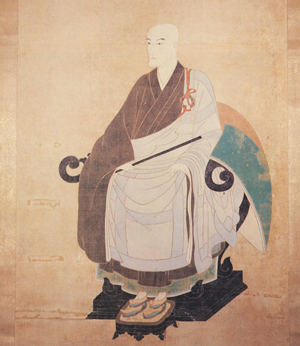
Isshi Bunshu - 1608-1645/46
Portrait preserved at the temple Hōjō-ji in Kameoka City, Kyōto Prefecture
Mid-1600s: MISCELLANEOUS PICTURES of LATE KOMOSŌ MAT MONKS

Painting of three komosō
Attributed to Iwasa Matabei, 1578-1650.
Possibly dating from the 1630s or 1640s.
Owned by the Shingon Sect temple Tōya-san Fumon-ji Taishō-in near Matsudo City in NW. Chiba Pref.
Source: Yamaguchi Masayoshi, 2005, p. 176.

Painting of three komosō
Acc. to Kakizaki Shōhō this picture dates from the Genroku Period, 1688-1704.
Link: "Genroku Period komusō figures"

Yet unidentified and undated early 17th century komosō picture.
Possibly dating from the 1630s, 1640s, or 1650?
Owned by Matsudo City Museum, Matsudo-shi, NW Chiba Pref.

Detail of the above picture.

Acc. to Bandō Jirō's weblog, however: From a (yet obscure) 17th century art work entitled
Jidai fūzokuga-fuku",
時代風俗画幅,
"Scroll with Pictures of Customs of the Time".
Postcard purchased by a companion of Bandō Jirō's at Matsudo City Museum in Autumn 2012
Link: Bandō Jirō's weblog
三節切 - MIYOGIRI

Mid-17th century 'miyogiri" - triple-node-cut shakuhachi
Source: The former website of John Singer
破鬼理死端/破吉利支丹 - HA KIRISHITAN by Suzuki Shōsan
1642: The former warrior, loyal supporter of Tokugawa Ieyasu, and also devoted Zen buddhist monk and writer, Suzuki Shōsan, 1579-1655,
completes his strongly anti-Christian essay
Ha Kirishitan, "Crush Christianity".
Acc. to George Elison, 1973/1988, p. xi, Ha Kirishitan first published in 1662.
Link to a complete reprint of Ha Kirishitan
Interestingly, Suzuki Shōsan was an outspoken admirer of Fuke Zenji, as evidenced in his 1648 work, Roankyo.
1649: Hiroshima Fief Authorities issue regulation to control 'Komosō' and other "troublemakers"
Source: Hosaka Hiro'oki, 1994
1651: A 'rōnin' revolt led by Yūi Shōsetsu is put down by the shōgunate.
1653 to 1687: The Shōgunate takes harsh legislative measures to regulate & control society including all social groups.
Namely: Warrior/samurai, farmer, craftsman, merchant,
religious, Imperial - and, not least: "outcast", like 'komusō' ex-samurai, fluteplaying beggars.
Source: Hosaka Hiro'oki, 1994
1657-1658: An attempted revolt involving both 'rōnin' and Christians is discovered and the rioters eliminated.
1657: The 'Tōzoku-jin sansaku jōjō', a government directive
to investigate 'Komusō' and other "outlaws", is issued.
1658 - KYŌ WARABE
京童
By Nakagawa Kiun,
中川喜雲, 1636-1705
Printed by Yamamori Rokube-e,
山森六兵衛, Kyōto

Two wandering flute players pictured in the 'Kyō warabe' vol. 4, 1658
The oldest extant, reliably dated
picture of possible early Edo period 'komusō'
Picture in Ueno, 2002, p. 218.
Do note: It was first during the late 18th and early 19th centuries that the characteristic bee-hive shaped 'tengai' basket hat reached its final form.

The 'Kyō warabe' by Nakagawa Kiun
The Remembering the Capital Archive, Kyōto
Source URL:
Frame 13 in Volume 4 of the 'Kyō warabe'.
Source: The Remembering the Capital Archive, Kyōto.

The 'Kyō warabe' by Nakagawa Kiun
Waseda University Library, Tōkyō
Source URL:
Volume 4 of the 'Kyō warabe' - scroll down to frame/PDF file page 13.
Source: Waseda University Library, Tōkyō

Detail of the above Remembering the Capital, Kyōto, version of 'Kyō warabe' volume 4 frame 13
Source URL:
Frame 13 in Volume 4 of the 'Kyō warabe'.
Source: The Remembering the Capital Archive, Kyōto.
1659 - or, perhaps in actual fact: 1752?:
Semi-legendary Kyōto Myōan Temple "reviver", Engetsu Ryōgen, and his documented 23 "temple" rules
Did an alleged Kyōto Myōan Temple "reviver", Engetsu Ryōgen, really lay down 23 regulatory statutes
for the temple's shakuhachi 'rōnin komusō' as early as in 1659?
Or, is this just yet another example of typical Edo Period 'komusō' document fraud?
1661:
WANTED: Believers in the Christian Faith - Earn a Reward !!!
キリシタン
禁制
の
高札 - KIRISHITAN KINSEI no KŌSATSU
"Public Proclamation About the Prohibited Christian Faith"
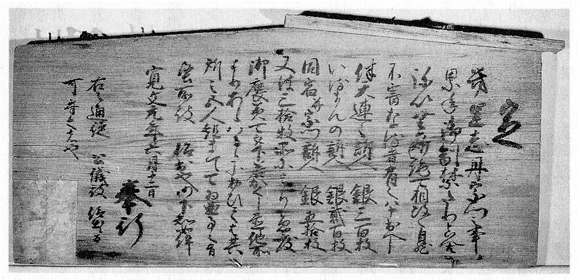
Reward proclamation, public sign board

Reward proclamation, wording
1:
伴天連之訴人 (ばてれん之訴人) 銀三百枚
2:
いるまんの訴人 (入満の訴人) 銀弐百枚
3:
同宿弁宗門訴人 銀五拾枚
- - -
寛文元年六月十二日
Japanese text about the promised rewards:
1: "A person who reports a Catholic Father (shall earn) 300 pieces of silver."
2: "A person who reports a non-ordained Christian monk (shall earn) 200 pieces of silver."
3: "A person who reports some one who speaks about the creed in the same place
= a lay believer (shall earn) 50 pieces of silver."
- - -
"Kanbun 1, 6th Month, 12th Day."
Trsl. by Torsten Olafsson, 2018.
Source: Fujii Joji, 2013, p. 69.
See many more examples of such prohibition signboards here, online:
Kinsei no kōsatsu Prohibition Signboards
黄檗禅 - ŌBAKU ZEN
1661: The Ōbaku Zen sect - an "import" from continental China - is established in Japan, with the temple Manpuku-ji in Uji as its mother temple.
Official recognition is bestowed on this new side branch of the Rinzai Zen sect by prominent both Shōgunal and Imperial support and decree.
Still, the Ōbaku monks remained organized as only a sub branch of the established Kyōto Rinzai hierarchy, and it was only as late as in 1876 that the Ōbaku Sect eventually achieved full status as a genuine Zen sect in its own right - something that never happened to the so called "Fuke Sect".
1661 or 1665 - UKIYO MONOGATARI by ASAI RYŌI
浮世物語 - "Tales from the Floating World"
浅井了意 - ASAI RYŌI - c. 1612-1691

Here you see a genuine, original picture of possibly two 1660s, very early komusō being featured in the short story collection 'Ukiyo monogatari', "Tales of the Floating World", by Asai Ryōi.
This really rarely shown illustration was reprinted/reproduced in 1916 in a very comprehensive 12 volume collection of selected masterpieces of Japanese Tokugawa Period literature,
the 'Tokugawa bungei ruiju', Volume 2.
The short story with that particular unique picture attached does not at all mention any neither 'komo-sō', nor 'komu-sō',
so the two flute playing persons could only have been placed in the illustration to create some sort of an authentic 'cosy' atmosphere for the narrative.
As you can see - very contrary to several more recent really poor, misleading redrawn copies of the two figures - the flute being played in the front is both thin and quite long,
i.e. not at all a 'konjiku',
根竹
"root-end", type of 'shakuhachi'.
So, what do you honestly think those two flute players were actually playing when wandering around, from gate to gate, begging their humbly best to hopefully survive?
I myself believe: Definitely not any 'honkyoku'!
1664: The shōgunate, or bakufu, orders every daimyō to establish in their domain an officer of religious investigation, i.e. either a magistrate of religion (shūmon bugyō) or magistrate of temples and shrines (jisha bugyō).
1665: Registries of religious affiliation are now being produced on a nationwide scale.
The registry's format is finally standardized in 1671 - the system of religious inspection and obligatory temple certification
has now become completely consolidated by law and is carried out effectively, on a yearly basis, in all of Japan.
1664 - The First Known Account of some Active Kyōto Komusō
- Written by a Contemporary "Outside Observer and Witness"
こむ
僧
の
手 - KOMUSŌ no TE - "Music of the Komusō"
1664 - SHICHIKU SHOSHINSHŪ by NAKAMURA SŌSAN
糸竹初心集

The Komusō chapter in Shichiku Shoshinshū,
1773 edition (An'ei 2), Part 1, page 6
Waseda University Library, Tokyo
虚無僧尺八というは
長さ一尺八寸に切ゆえ尺八というとぞ、
濫觴はたしかに不知、
そのかみ由良の法燈此道の祖たるよしいへども
了簡せず、
昔よりぼろぼろの家に用る物と聞こえたり、
梵字、漢字、色おし、 しら梵字などいひしもの
此尺八の執行者と聞こえたり。
近き此不人というこむ僧有て、
「ごろ」という手お吹出し、その外「れんぼながし」、
「京れんぼ」、「さむ也井川」、「吉田」
などいうさまざまの手有之、
いづれも律呂の調子にあはせたる物とは聞こえず、
されども我道にあらざれば、其深き事をしらず。
"The komusō shakuhachi is named 'shakuhachi' because its length has been cut to the measure of 1 foot and 8 inches.
Its origin is certainly unknown.
Although it is being said that Hottō of Yura [Shinchi Kakushin, ed.] was the founder [of the komusō, ed.], that I do not ascertain.
One hears that, since ancient times, this thing [the shakuhachi, ed.] was used by the 'boroboro' practitioners, and also that the socalled 'bonji', 'kanji', iro-oshi', and
'shira-bonji' were people who performed this shakuhachi ceremoniously.
There are nowadays some outcasts [Jap.: fu-nin, "non-persons", ed.] who are called 'komusō';
they are blowing a piece of music named:
'Goro' - besides there are other tunes such as:
'Renbo Nagashi', 'Miyako Renbo', 'Samunaru Ikawa', and 'Yoshida'.
One does not hear any of these pieces being played in the 'ritsu' [Dorian, ed.] or the 'ryō' [Mixolydian, ed.] musical modes.
As this, however, is not the tradition of my own, I do not know about this matter in depth."
Written and published by Nakamura Sōsan, 1664.
Trsl. by Torsten Olafsson, 2010.
Sources: Ueno, 1983, pp. 204 & 280, and
Shichiku Shoshinshū, 1773 edition,
Part 1, p. 6, owned by Waseda University, Tokyo.
This is, to the best of my knowledge, the oldest extant text
in which names of komusō music pieces are recorded.
An old copy of the Shichiku Shoshinshū is preserved
at Waseda University, Tokyo.
Follow this link to study a full photographic documentation
(PDF, 15,8 MB) of the book: Shichiku Shoshinshū.
Go to PDF page 5, right side, to study the komusō chapter.
Link to Shichiku Shoshinshū, bibliographical details.
Copyright restricted © by Waseda University, Tokyo.
|
|
















































